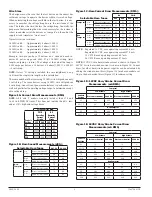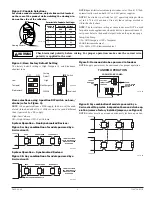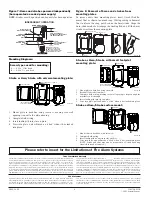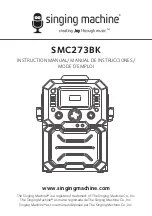
D900-28-00
2
I56-1796-011R
Wire Sizes
The designer must be sure that the last device on the circuit has
sufficient voltage to operate the device within its rated voltage.
When calculating the voltage available to the last device, it is nec-
essary to consider the voltage drop due to the resistance of the
wire. The thicker the wire, the less the voltage drop. Generally, for
purposes of determining the wire size necessary for the system, it
is best to consider all of the devices as “lumped” on the end of the
supply circuit (simulates “worst case”).
Typical wire size resistance:
18 AWG solid:
Approximately 8 ohms/1,000 ft.
16 AWG solid:
Approximately 5 ohms/1,000 ft.
14 AWG solid:
Approximately 3 ohms/1,000 ft.
12 AWG solid:
Approximately 2 ohms/1,000 ft.
Example: Assume you have 10 devices on a zone and each re-
quires 50 mA average and 2000 Ft. of 14 AWG wiring (total
length=oureturn). The voltage at the end of the loop is
0.050 amps per device x 10 devices x 3 ohms/1,000 ft. x 2000 ft
=3 volts drop.
NOTE:
If class “A” wiring is installed, the wire length may be up
to 4 times the single wire length in this calculation.
The same number of devices using 12 AWG wire will produce only
2 volts drop. The same devices using 18 AWG wire will produce
8 volts drop. Consult your panel manufacturer’s specifications, as
well as SpectrAlert’s operating voltage range to determine accept-
able voltage drop.
Figure 1A: Current Draw Measurements (RMS)
NOTE:
All ‘S’ and ‘P’ models were only tested at the 8-17.5 and
16-33 Volt-FWR/DC limits. This does not include the 80% low-
end or 110% high-end voltage limits.
Strobe Current Draw
Candela
Setting
FWR
Operating
Current
Strobe
DC
Operating
Current
Strobe
12V
24V
12V 24V
15
112
64
127
59
15/75
135
74
127
69
30
93
90
75
158
160
110
208
209
Figure 1B: Horn Sound Measurements (dBA):
Selectable Horn Tones
8-17.5V
16-33V
Temporal
Low
Volume
Electromechanical
67
75
3000 Hz Interrupted
68
75
High
Volume
Electromechanical
71
80
3000 Hz Interrupted
72
81
Non-
Temporal
Low
Volume
Electromechanical
71
79
3000 Hz Interrupted
72
79
High
Volume
Electromechanical
76
84
3000 Hz Interrupted
77
86
Figure 1C: Horn Current Draw Measurements (RMS):
Selectable Horn Tones
DC
FWR
12V
24V
12V
24V
Temporal
Low
Volume
Electromechanical
15
23
13
23
3000 Hz Interrupted
15
33
13
23
High
Volume
Electromechanical
36
53
20
44
3000 Hz Interrupted
43
57
21
40
Non-
Temporal
Low
Volume
Electromechanical
16
37
19
29
3000 Hz Interrupted
16
32
18
33
High
Volume
Electromechanical
38
49
46
49
3000 Hz Interrupted
44
56
42
58
NOTE:
Regulated 12 VDC, max operating current 44.4 mA
Regulated 24 VDC, max operating current 57.0 mA
12 V FWR, max operating current 45.7 mA
24 V FWR, max operating current 57.5 mA
NOTE:
12VDC 2-wire horn/strobe current is shown in Figure 1D.
24VDC 2-wire horn/strobe current is shown in Figure 1E. Current
draw for other horn/strobe power supplies can be calculated by
adding the strobe current draw (Figure 1A) for chosen candela set-
ting to the horn current draw (Figure 1C) for chosen setting.
Figure 1D: 12VDC Horn/Strobe Current Draw
Measurements (mA RMS)
Temporal
Low Volume
High Volume
Candela
Setting
Electromechanical
3000 Hz
Electromechanical
3000 Hz
15
111
111
112
112
15/75
127
127
126
129
Non-Temporal
15
113
112
114
115
15/75
128
128
130
134
Figure 1E: 24VDC Horn/Strobe Current Draw
Measurements (mA RMS)
Temporal
Low Volume
High Volume
Candela
Setting
Electromechanical
3000 Hz
Electromechanical
3000 Hz
15
71
70
73
75
15/75
86
85
87
88
30
99
98
100
100
75
166
166
167
170
110
209
209
210
213
Non-Temporal
15
74
74
79
82
15/75
86
88
93
96
30
101
101
107
110
75
167
167
173
176
110
213
213
218
222






















